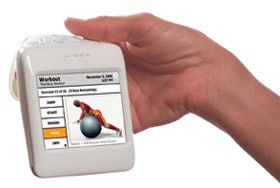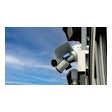Trainers and e-training devices are finding more profitability by making peace, not war.

"The better technology companies will have an interface whereby a personal trainer can get in the back door, meaning the trainer can go in and manipulate the workout programs," says Gregory Florez, CEO of fitadvisor.com and a spokesman for the American Council on Exercise. In order for personal trainers or new personal training devices to prosper, says Florez, they must be willing to collaborate with one another. "They've got to be partners and not enemies," he says.
In a Saturday Night Live skit that NBC aired in 1995 - on the precipice of the dot-com boom - Sam Waterston played a "robot attack insurance" salesman, cashing in on the irrational fears the elderly have of technological advancements. Fast-forward two or three years, and the skit could easily apply to some people in the fitness industry - especially personal trainers - many of whom felt their livelihood endangered by virtual fitness training on the burgeoning Internet.
"There were all these companies that said, 'Let's just offer online personal training programs and we'll all make millions of dollars,' " says Florez. That elicited "an almost universal backlash" from personal trainers, if only because companies were targeting fitness club owners with in-house personal training services.
"A lot of club owners were being pitched on these things and trainers were feeling very, very threatened," Florez says. " 'You're telling me that if I purchase your service, your kiosk, or whatever the product is, I'll be able to continue making money on personal training, but it will also be less expensive per member and my margins will be higher?' It sounds good all the way around." That selling point was, and still is, especially appealing to clubs that don't offer in-house personal training, Florez argues. "In a lot of clubs, since their business is really selling memberships, vitamins and group exercise classes - not personal training - they're taking a serious look at technology solutions."
While a handful of fitness training technology providers have prospered, most crashed and burned along with thousands of dot-com boomers in other industries. The reason in the fitness field, Florez says, is companies were simply "spitting out" preprogrammed workouts for exercisers, most of whom would eventually lose interest and motivation. But newer waves of companies are marketing products that allow for more - and more varied - interaction between exercisers, trainers and the training devices they may both employ.
The Progio, for example, is a handheld device that gives step-by-step instructions (through text cues, still images and even video) guiding users through any of thousands of workouts obtainable through several different online providers, including the Progio web site. The device has a heart rate monitor and built-in workout interval timers, allowing it to track an exerciser's progress. The company's web site says owning the Progio is "like having your personal trainer in your pocket, anytime, anywhere." That type of claim scares personal trainers, says Dirk Bartels, founder and CEO of Companion Worlds Inc., which makes the Progio. "They're threatened. We hear that quite often," he says. "It seems like that's the natural reaction to any kind of virtual coaching technology." But Bartels argues that his product can only serve to enhance the relationship between a trainer/coach and his or her clients.
"The premise behind the Progio is that you can put all the information that your trainer provides you into a mobile device that you can then take with you to wherever you do your workout," he says. "A person can send workout results back to the trainer as an accurate way for him or her to review all the information, make assessments and adjust the training based on the actual progress the client has made."
The result, argues Bartels, is that trainer and client can both have freer schedules, more accurate workout data and more finely tuned workout plans. "This tool cannot replace human interaction, but I think it opens up a lot of new opportunities," he says. "Right now we're seeing a lot of people using it as a complement to their coaches."
Another product attempting to integrate human interaction and fitness technology is the Bodybugg, a small device attached to an armband designed to continuously track the number of calories an exerciser consumes versus the number he or she expends. The product comes with a web-based program featuring myriad online fitness resources and two free phone consultations with a (human) "Bodybugg coach." More private counseling sessions are available for purchase. "It's like having your own personal fitness and nutrition consultant at your fingertips 24/7," the company's web site claims.
Well-established fitness equipment manufacturers also are embracing the benefits of virtual personal training. Life Fitness, for one, offers the new 95 Series line of treadmills, which boasts - among a slew of new technology-based features including iPod integration - a "virtual trainer" option. The trainer is really an animated man or woman - depending on the user's preference - that can be turned on or off, and appears on the treadmill's monitor to guide people through new workouts and occasionally offer motivational cues and updates on workout progress. The company developed the "virtual trainer" option after extensively surveying both users and customers.
"It's really just to add motivation and education, all at the user's fingertips," says Bob Quast, the company's vice president of product management. "People asked for it, unsolicited in the research. They didn't say they wanted a personal trainer specifically, but they said they wanted someone or something to walk through the workout with them." But the real personal training tool built into the 95 Series, Quast says, is a USB port, through which exercisers can bring their own USB stick that can save their past workout data and/or contain new customized workout programs. Trainers in years past may have been leery of such advanced technology, but Quast says many trainers are now willing to make such features work for them. "The trainer can't always be there," he says. But with the memory stick/treadmill compatibility, he says, "a trainer can give a customer a preloaded program that they've customized."
Most new e-training product-makers unabashedly claim compatibility with the goals of fitness professionals, but it's still uncertain how well trainers and club owners will adapt in a world where an increasing number of clients are coming to them already wired with more advanced devices.
Richard Cotton, chief exercise physiologist at myexerciseplan.com, suggests that for several years, advancements in fitness technology have outpaced the evolution of most fitness professionals, to the detriment of people on both sides of the industry. "Along with all the high-tech, there has to be parallel growth in high-touch," he says. " 'If you build it, they will come' just isn't going to work anymore. You can give someone a bunch of data, and they'll think it's cool, but it's not really going to motivate them over the long haul." Cotton says he often encounters trainers who are wary of his web site, which caters both to exercisers looking for programs designed to help them meet their specific life goals, as well as trainers looking for new resources and support tools. But Cotton contends that most trainers shouldn't fret, since web-based training resources alone can't create a sustainable (or, for trainers, profitable) exercise enterprise.
"A lot of personal trainers and fitness professionals are still primarily selling fitness on amenities, not the underlying, life-affirming benefits of exercise," says Cotton. "In terms of just spreading information, electronics does replace a personal trainer. But if information is all some trainers are providing, then they had better find another business."
































